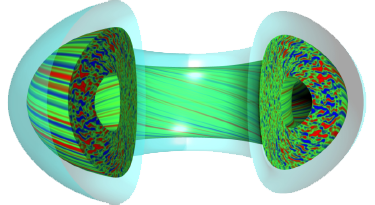Speaker
Description
Bayesian inference provides the ideal framework for modelling complex systems made of multiple heterogeneous measurements. Independent generative models of plasma diagnostic measurements can be implemented in a modular way and used to carry out Bayesian inference within a single consistent Bayesian model which relates few common plasma parameters to different kinds of observations. Unfortunately, it is often the case that for complex models, carrying out Bayesian inference with traditional algorithms such as MCMC can require long omputational times. The paper proposes a framework to train deep neural networks to approximate Bayesian inference in order to accelerate it: results conducted on experimental data collected at the Wendelstein 7-X experiment with a multi-line-of-sight X-ray imaging diagnostic and a single line-of-sight spectrometer, and at the JET tokamak with a He-beam diagnostic are promising. An acceleration up to 6 order of magnitude is achieved when the trained artificial neural network is valuated on experimental data to infer plasma parameters such as electron and ion temperature, the plasma effective ion charge, and the edge electron density. One main novelty of such approach is the following: the training data are generated from the Bayesian model that is the target of the fast approximation by sampling from the prescribed joint probability distribution. In particular, the neural network can be trained to infer plasma parameters from the observations, the joint probability distribution value conditioned on the observations, or it can be trained to approximate the posterior distribution of the parameters. Also, uncertainties on the neural network output can be calculated with MC dropout, a variational Bayesian inference approach to the network learning problem. The suggested approach is general, in the sense that it can be carried out on any given Bayesian model. In order to facilitate the automation of the implementation of the method described, it is particularly useful to have one common interface to different plasma physics models: in our case, this is provided by the Minerva Bayesian modeling framework which prescribes a modular environment to express Bayesian models of different kinds. In this way, traditional Bayesian inference can be accelerated, and, on the long term, fast surrogate Bayesian models can be used in possible real time applications which require fast evaluation of experimental data together with appropriate uncertainty calibration. The application described in the paper will provide present and future nuclear fusion experiments with novel chances of automation in experiment planning, execution and diagnosis.
| Country or International Organisation | Germany |
|---|---|
| Affiliation | Max-Planck Institute for Plasma Physics, Greifswald branch |

